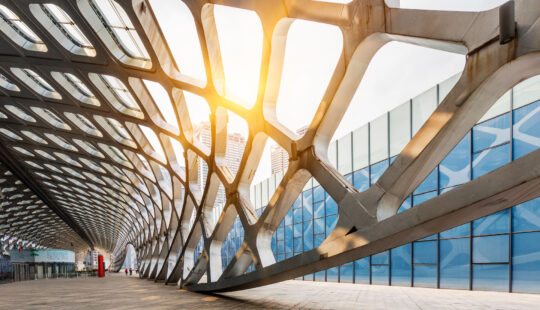It takes around 200 terawatt-hours of electricity each year to power all the data centers around the world. That’s almost enough electricity to power South Africa for a year and represents around 1% of global electricity demand.
Although internet traffic has significantly increased year over year, the proportion of electricity that data centers consume has remained relatively constant over the past 10 years, as the International Energy Agency (IEA) reports. This is because many businesses have moved from small, less efficient data centers to ones that use more efficient servers and infrastructures.
The Cloud Is the Key
To simplify the transition to the cloud for customers, in early 2021 SAP launched RISE with SAP consisting of cloud solutions and services that support customers on their digital transformation journey. The response has been positive, helping the company reach its ambitious cloud growth target: by 2025, SAP expects to generate more than €22 billion in cloud revenue. SAP is working with the four largest hyperscale providers currently dominating the cloud market: Amazon Web Services, Microsoft Azure, Google Cloud Platform, and Alibaba Cloud.
SAP Cloud customers can choose whether to use one of SAP’s data centers; a co-located data center; or, depending on the solution, one or several hyperscale data centers. To further build out its cloud software infrastructure, in early 2021 SAP launched the Next-Generation Cloud Delivery initiative, targeted for completion in late 2022.
“Through this initiative, we are consolidating the infrastructure and the various platforms that we have today,” explains Jürgen Sattler of the Next-Generation Cloud Delivery team. “We are migrating customer software to a state-of-the-art environment, which our new customers use from day one. By modernizing our infrastructure, it will be easier for us to scale in the future, and we will be able to provide customers with better service-level agreements.” Existing cloud customers are being migrated to the new environment during normal maintenance windows, which are usually on the weekend. “Once the program is complete, we will be running in a harmonized environment on our own cloud and on the four strategic hyperscalers,” says Sattler.
Green Data Centers
As customers migrate to the cloud, data centers play an increasingly important role in making solutions available to them, and, as such, in customers’ sustainability strategies. Running solutions in SAP data centers and using hundreds of cloud solution transactions every day requires processors, memory, storage devices, and cooling systems. This requires electricity, which produces carbon emissions, and water – and generates electrical and electronic waste. Customers must often report this energy use and other metrics in their sustainability reports.
The data centers at SAP headquarters in Germany and North America have been certified according to ISO 14001. This certification ensures that SAP manages its data center operations and responsibilities in a systematic and environmentally conscious way, monitors its environmental performance, and continuously improves its impact on the environment.
Since 2014, SAP uses renewable electricity to power all its facilities, including its own and external co-located data centers. And, to ensure its use of hyperscale data centers is also carbon neutral regardless of the sustainability strategy put in place by the provider, SAP generates renewable electricity in selected SAP locations worldwide and makes investments into high-quality, EKOenergy-certified energy attribute certificates. All of these steps make a significant contribution to SAP’s commitment to become carbon neutral in its own operations by the end of 2023 and achieve net-zero along the entire value chain by 2030. In its efforts to become carbon neutral while still growing the business, SAP is focusing on a three pillar approach: “avoid-reduce-compensate.” Customers can also draw on SAP’s green cloud solutions and services to significantly reduce their own carbon emissions to help support their sustainability strategies.
White Paper on Making Data Centers Green
“Customers often ask us what we are doing to minimize the environmental impact of our cloud solutions,” says Gergely Gulis, a data center architect at SAP. “Green data centers help our customers make their entire value chains more sustainable.” A new SAP white paper outlines the industry standards and best practices that the SAP Global Cloud Services Data Center Management team follows to design, operate, and decommission SAP data centers across the globe, ensuring their lifecycle is sustainable. It also provides the basis for the next logical steps in making cloud activities greener.
The white paper covers topics such as:
- Energy-efficient data center infrastructure and IT devices
- Optimization of cooling and, where possible, reduced cooling
- Use of a cold/hot aisle containment concept to save energy
- Use of thermal cameras to optimize air flow and insulation
- Reduction of electrical waste and increased recycling
- Reduction of water consumption
- Use of performance indicators for energy efficiency, water consumption, electrical waste, and more
Digital Companies Are More Sustainable
With SAP customers accounting for 87% of total global commerce, SAP is in a unique position to provide valuable market insights into technology’s impact on profit and planet. Following our analytical investigation of the correlation between digital maturity and business performance with BCG, S&P Global, and AlphaSense, we applied the same externally validated methodology from IDC to sustainability.
The results show that companies with higher digital maturity have better sustainability performance as reflected in ESG scores, which measure a company’s exposure to long-term environmental, social, and governance risks. These risks – involving issues such as energy efficiency, worker safety, and board independence – have financial implications.
After analyzing sustainability performance for 8,685 publicly traded companies representing US$47 trillion in annual revenue through S&P Trucost Limited and ESG Global Scores, the outcomes are clear – companies with higher digitally maturity have:
- 75% higher ESG scores compared to their peers in their industry
- Better individual E Scores, S Scores, and G Scores
- 24% lower CO2e emissions
Sustainable Data Center Deeply Anchored in New Global Environmental Policy
To execute on SAP’s accelerated commitment to net-zero by 2030, which includes a special emphasis on sustainable data centers, SAP updated its Global Environmental Policy. The policy became effective on May 1, 2022 and guides SAP’s environmental action by outlining specific global environmental objectives, focus areas, and guiding principles – further strengthening its pledge to reduce the ecological footprint of its operations, its value chain, and its solutions.



